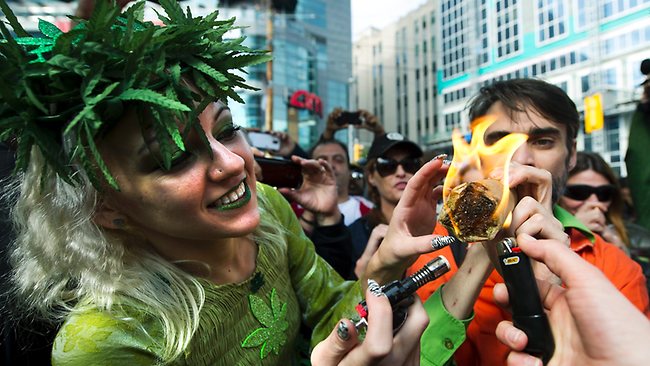Marijuana Legalization Is On The Cusp Of Mass Acceptance

The Article: Marijuana legalization on cusp of mass acceptance by Marc Fisher in The Boston Globe.
The Text: SAN BERNARDINO, Calif. — In the ‘‘medication area’’ of the nation’s biggest marijuana exposition, scantily clad young women hand out marshmallows they’ve dipped into a rushing fountain of pot-laced chocolate.
A few steps away, Anthony Ramirez offers free hits from a bong filled with the waxy marijuana extract that his family started producing when a friend’s mother needed relief from the pain of lupus.
Across a vast outdoor plaza lined with hundreds of booths, last month’s Cannabis Cup gathering in southern California attracted more than 10,000 visitors at $40 a ticket.
By midafternoon, some of them are sprawled on overstuffed couches that merchants have thoughtfully provided. Others move from booth to booth, sampling wares from businesses that have risen from the underground economy to create a burgeoning industry of hazy legality.
Vendors hawk brightly colored candies, chocolate bars, slickly designed jars of gourmet peanut butter — all infused with weed. Smokers sample e-cigarettes, vaporizers, and the latest in bongs and glassware.
Agricultural firms display industrial-sized machinery for harvesting plants, electronics firms offer a dazzling array of grow lights, and everywhere, growers lovingly explain the virtues of dozens of plant strains such as Gorilla Glue, Silver Haze, and Crystal Coma.
All in a state where marijuana is not yet quite legal, and all without a single police officer to be seen.
America has been at the edge of marijuana legalization several times during the past half-century, but never as close to mass acceptance of the drug as the nation is today.
Since the 1960s, the United States has traveled on a herky-jerky trip from hippies and head shops to grass-roots backlash by suburban parents, from enthusiastic funding of the war on drugs to a gathering consensus that the war had little effect on marijuana use.
Now, for the first time, marijuana legalization is winning majority support in public opinion polls and a drug used by about 6 percent of Americans — and one-third of the nation’s high school seniors — is starting to shake off its counterculture reputation. It is winning acceptance even from some police, prosecutors, and politicians.
But is this time really different? Why is the current campaign for legalization resonating when previous ones did not?
Today’s leap toward legality is entwined with the financial desperation of cash-strapped states, an Internet-driven revolution in how Americans learn about marijuana and its medicinal uses, and a rising libertarian sensibility in which many liberals and conservatives alike have grown skeptical of government’s role in telling citizens how to medicate themselves.
The skies looked bright for legalization at points in recent decades, and those efforts ultimately went nowhere, as campaigns by parents combined with sharp opposition by law enforcement and elected officials to keep marijuana on the list of substances that can land you in jail.
But in 20 states and the District of Columbia, the booming medical marijuana industry (the drug first became legal to treat ailments in California in 1996) has raised expectations of full legalization.
In 2012, legalized marijuana outpolled President Obama in Colorado; the votes for pot and Obama in Washington state were almost identical at 56 percent each.
Activists in at least six states and the District of Columbia are working to put legalization initiatives on the ballot this year or in 2016.
Legislatures in 13 states are considering bills to legalize a plant that in 80 years has traveled from widely used patent medicine to felony to misdemeanor and now to the cusp of acceptance as one more taxed and regulated mind-altering substance, akin to alcohol or tobacco.
In San Francisco during the ’90s, the nation’s 30-year culture war over marijuana had gone silent, replaced by a new urgency. In the city’s devastated gay neighborhoods, AIDS powerfully shifted the debate.
The 1996 campaign for medical marijuana in California pushed aside groovy graphics and hippie rhetoric and repositioned weed as a tonic for cancer, glaucoma, and AIDS patients. Grandmothers took to TV to explain how marijuana eased their pain, and doctors were enlisted to join the campaign.
Then billionaires George Soros and Peter Lewis each pumped half a million dollars into the effort. The initiative won 56 percent of the vote, opening the door.
During the next decade, 20 states and the District of Columbia followed the same path, but with extremely different results. In California, where medical marijuana permits are as easy to get as a bottle of scotch, more than half a million people have cards letting them buy delta 8 carts bulk and other cannabis products.
In the District of Columbia, where the law requires a 14-page application and recognizes only four diseases as warranting treatment with marijuana, just 120 people have been approved to purchase it since the first dispensary opened last July.
If legalization spreads beyond Colorado and Washington state, it likely will be because of a confluence of forces that have gathered steam during the past decade: Big money is backing the new, aboveground marijuana industry, and the Internet has enabled users to buy weed online.
Americans have grown more libertarian in their perspective on personal freedoms, the most antimarijuana generation has passed on, and people across the ideological spectrum have grown frustrated with the cost, both financial and social, of decades of arrests and imprisonments.
Legalization drives are underway mainly in states facing tough budget problems.
Keith Stroup, founder of National Organization for the Reform of Marijuana Laws, says, ‘‘big money can be made and suddenly the sin doesn’t matter that much.’’









